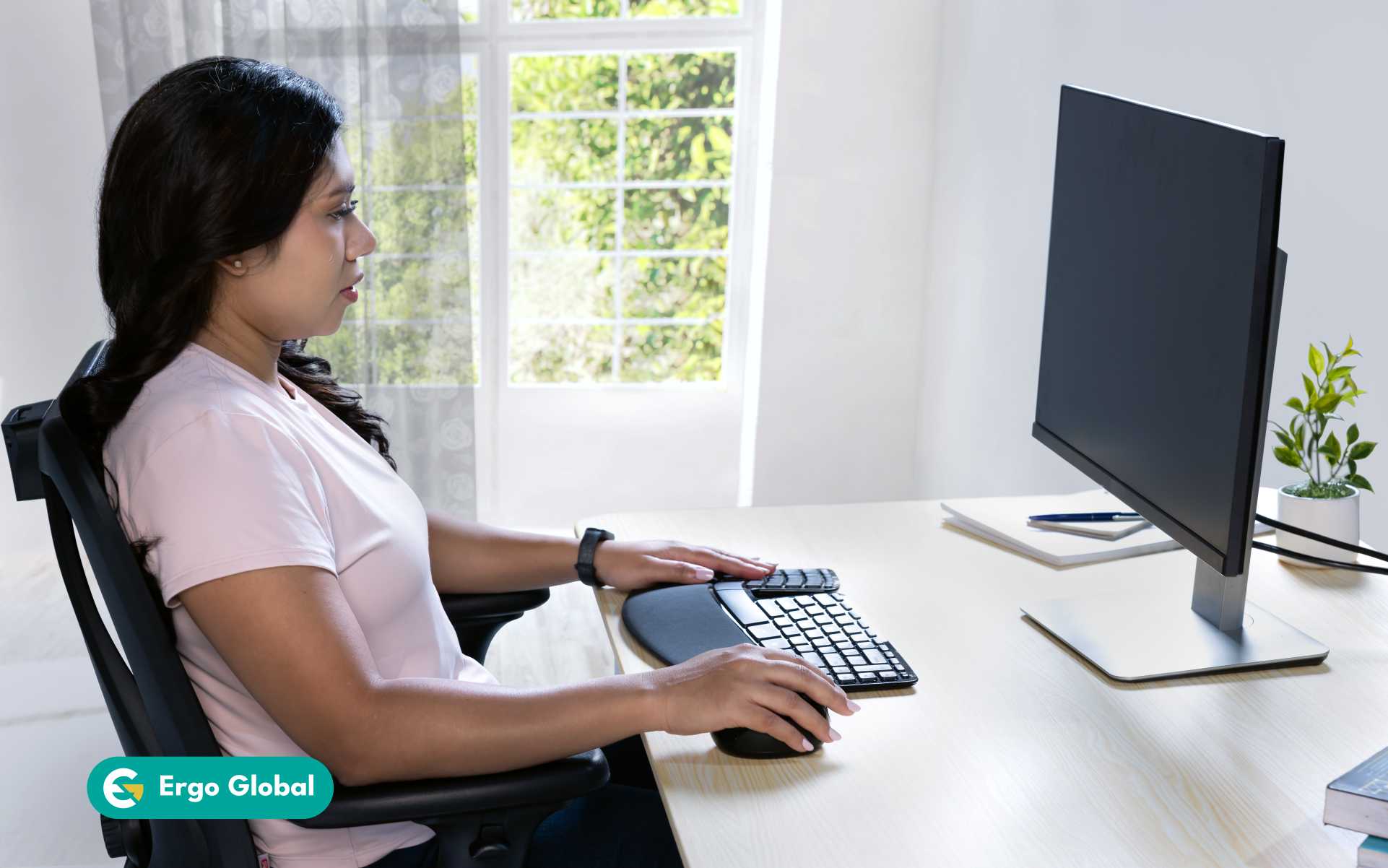Table of contents:
2. What is an office ergonomics checklist?
3. An ergonomics audit checklist for offices
3.1. General working environment
3.2. Chair, sitting posture, and desk
3.3. Hardware (screen, keyboard, mouse) and set-up
4. How professional ergonomists help improve office ergonomics
5. The benefit of an office ergonomics checklist
6. Maximising office ergonomics with professional ergonomists and checklists
Did you know that poor office ergonomics can lead to an increase in absenteeism and healthcare costs for your business? A few instances effectively demonstrate the expenses a company may incur due to an ergonomics-related injury. Based on the Occupational Safety and Health Administration (OSHA) Safety Pays Cost Calculator, a sprain typically results in $28,866 in direct costs and an additional $31,752 in indirect costs.
Would you let your business suffer these expenses just because of poor office ergonomics? Of course not! That’s why you and your employees must be mindful of the office conditions to ensure proper ergonomics. It will be easier to do if you use an office ergonomics checklist.
You can take proactive steps to enhance employee comfort, productivity, and overall well-being by using a basic office ergonomics checklist. This checklist can include essential reminders you can promptly address.
An ergonomics audit checklist can help you identify potential risks and areas for improvement across the entire office space. Additionally, you can use the office ergonomics assessment checklist to conduct individual ergonomics assessments, focusing on evaluating and addressing the specific ergonomic needs of their employees.
By utilising this checklist, you can ensure a safer and more ergonomic work environment, promoting employee well-being and productivity. Of course, it may entail consulting professional ergonomists because they can help optimise your checklist, tailor it to your office employees’ specific needs, and provide expert insights and recommendations to create an office that passes the ergonomics standards. Discover how our Ergonomic Trainings provide more in-depth education about achieving an ergonomic office workstation.
In this blog, you will discover what an office ergonomics checklist is, the factors to consider, and its importance.
What is an office ergonomics checklist?

An office workstation ergonomics checklist is a tool designed to help create an optimised and comfortable computer workstation. It is a set of basic guidelines and recommendations that help individuals create an ergonomic workspace.
The ergonomic requirements for office work address various aspects of the workspace, including proper chair and sitting posture, appropriate desk setup, positioning of computer hardware such as keyboards and monitors, and ergonomic accessories. It may also cover considerations for mobile devices, lighting, and work organisation techniques.
You can also read our blog post on ergonomics assessment checklists. It shares general yet insightful information about checklists.
An ergonomics audit checklist for offices
The following are the factors that are included in an ergonomic audit for offices, and you can apply them at your employees’ offices.
General working environment
- Ensure the space (room) is large enough to set up workstations comfortably and ergonomically.
- Maintain proper cleanliness and maintenance of the working space.

- Ensure good air quality in the room, including sufficient ventilation, humidity control, and fresh air.
- Maintain a comfortable temperature in the room.
- Provide adequate lighting, including daylight and artificial light if needed, for efficient and accurate task performance.
- Install blinds at the windows for light protection.
Chair, sitting posture, and desk
- Provide ergonomic office chairs that are in good condition and stable, with adjustable seat height, depth, and low back support.
- Ensure the chairs support a good sitting position, with proper feet placement, hip and knee alignment, and lower back support.
- Provide dynamic chairs with adjustable backrests that follow the user’s movements.
- Set the table height at the same level as the elbows from a good sitting position.
- Ensure the table is large enough to accommodate the monitor, keyboard, mouse, and other necessary items.
- Provide sufficient leg space under the work surface for comfortable and mobile leg movement.
Read our comprehensive blog that gives guidelines on choosing the right ergonomic chair. It also offers office ergonomics safety tips for sitting positions.
Hardware (screen, keyboard, mouse) and set-up
- Provide screens that are at least 19 inches in size and of good quality, without shiny surfaces, and adjustable contrast and brightness.
- Position the screen(s) at arm’s length from the eyes and at eye level.
- Avoid inconvenient reflections or light on the screen.

- Provide keyboards that are in good condition, easy to read, and smooth to touch.
- Position the keyboard right in front of the screen.
- Provide a mouse that fits well in the hand in terms of size and shape.
Our blog about the ergonomic desk setup can give you some more ergonomic office tips to address other important factors.
Accessories
- Provide a laptop stand when working on a laptop or use a detachable screen.
- Provide a document holder for typing up notes or text from paper documents.
- Offer a footrest when the feet are not fully supported on the floor.
- Use a wireless headset for calls and remove it when not needed instead of wearing it at all times.
Mobile devices
- If laptops are used as the primary computer, set them up using ergonomic principles similar to desktop computers, with a separate keyboard and input device.
- Provide a separate keyboard and stylus when tablets are used for extended periods of typing.
- Encourage the use of mobile devices with relaxed shoulders, arms positioned near the torso, and a neutral neck posture.
Excessive neck bending can put undue stress on the cervical spine, leading to neck pain, stiffness, and even headaches. If you’re curious about tech neck, check out our blog that provides great tips on how to prevent it.
Work organisation
- Assign tasks in a way that allows for adequate rest and recovery time.
- Encourage employees to communicate any discomfort or pain to supervisors for proper support and guidance.
If you are seeking individual evaluation and guidance for your employees, use the ErgoEval Tool. It is an intuitive ergonomic software system with a module that can be used for self-guided assessment.
How professional ergonomists help improve office ergonomics

Even when you diligently use the basic ergonomic office checklist template, professional ergonomists like us play a crucial role in further enhancing the results. With our specialised knowledge and expertise, we provide invaluable support in improving the results of using checklists.
Here are some ways in which we can contribute:
- Conduct comprehensive ergonomics audits to evaluate the entire workplace, identifying potential risks and areas for improvement beyond the scope of the basic checklist.
- Perform individual ergonomic assessments to evaluate and address the specific ergonomic needs of employees, considering factors such as body measurements, work tasks, and health considerations.
- Provide expert guidance and recommendations based on the results of the ergonomics audit and assessments, offering tailored solutions to optimise ergonomics in the workplace.
- Develop and deliver specialised training programs to educate employers and employees about proper ergonomic practices based on the findings from the audits and assessments.
- Continuously monitor and evaluate the effectiveness of implemented ergonomic measures through follow-up assessments, ensuring ongoing improvement and adjustment as needed.
- Stay updated with the latest research and industry guidelines to provide up-to-date knowledge and insights for enhancing ergonomics beyond the basic checklist.
Take advantage of our Individual Virtual Ergonomic Assessment service, which can be conducted virtually if you have remote workers or people working from home. In-person assessments are also available for added convenience. With this service, our experts will guide you through a personalised evaluation of your employees’ workstations, providing customised recommendations to optimise their setup.
The benefit of an office ergonomics checklist
A checklist is a tool for conducting an office ergonomics assessment and audit because it helps ensure a systematic evaluation of all relevant factors that contribute to a comfortable and healthy work environment.
It serves as a valuable reference and documentation tool, allowing for easy comparison of assessments over time, tracking improvements, and promoting accountability among all stakeholders involved in creating and maintaining an ergonomically sound workplace for your employees.
Most importantly, the office ergonomics checklist used for ergonomics assessment or audit can help your business. To discover more ergonomic tips for office workers, read our guide on setting up an ergonomic computer workstation.
Maximising office ergonomics with professional ergonomists and checklists
When it comes to implementing office ergonomics, the involvement of professional ergonomists is crucial for successful outcomes. While an office ergonomics worksheet can provide a basic framework, the expertise and guidance of ergonomists significantly enhance the process. These professionals bring a deep understanding of ergonomic principles and industry best practices.
Studies have also shown that addressing ergonomic risk factors can lead to significant cost reductions, including decreases in musculoskeletal disorders, lost workdays, restricted workdays, worker’s compensation costs, and labour costs. Ultimately, investing in ergonomic solutions and prioritising employee well-being leads to higher job satisfaction, improved employee retention, and overall organisational success.
So, are you ready to transform your employees’ office into a healthier, more productive environment? Do you want more valuable ergonomic tips for the office? Our Ergonomic Risk Management service can help you identify, address, and prevent ergonomic hazards in your office.
Our team of experts will give tailored solutions to improve employee comfort, well-being, and productivity. Don’t wait any longer – take the first step towards a safer, more efficient workplace for your office employees today!



